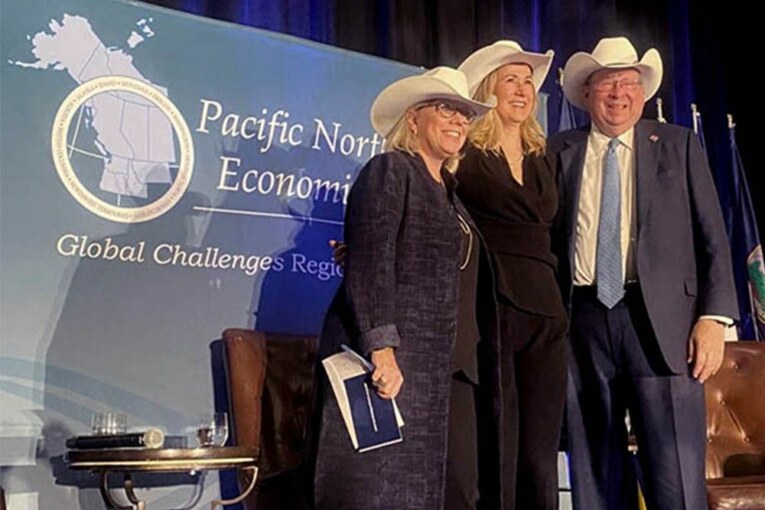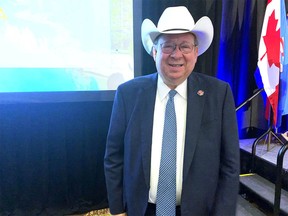
Canada’s ambassador to the United States and her counterpart from America sat down Monday in Calgary and talked about cross-border trade, developing critical minerals and energy security.
The more important get-together could come Wednesday.
That’s when Canada’s ambassador, Kirsten Hillman, and U.S. ambassador, David Cohen, take a trip to the oilsands with Alberta’s energy minister to view the mammoth operations that churn out oil from the largest crude reserves in North America.
“My goals are to go and see what’s happening, to talk to those that are involved in the projects out there, so that I can go back to the U.S. and talk about what’s happening in Alberta,” Hillman said Monday on the sidelines of the Pacific NorthWest Economic Region (PNWER) annual conference.
“I am happy to be going with David because I would like us to, while we’re there for a whole day together, talk these things through together. And I think that’s very important for our two countries.”
The opening day of the PNWER summit on Monday attracted more than 500 legislators and leaders from a number of jurisdictions, including Alberta, Saskatchewan, British Columbia, Yukon, Northwest Territories, along with the states of Alaska, Idaho, Montana, Oregon and Washington.
The opening panel of the cross-border economic conference saw both ambassadors discuss key issues between the two trading partners, such as the difficulties of travel coming out of the pandemic and the importance of developing critical minerals needed for the energy transition.
Energy is Canada’s largest export and the value of oil, gas and electricity shipped to the U.S. last year topped US$102 billion.
In turn, the U.S. is the largest supplier of foreign energy to Canada, sending $21.9 billion north last year.
However, the energy relationship — as with most things tied to oil and gas these days — is in a state of flux.
An energy crisis is rolling through Europe following the invasion of Ukraine by Russia. Prices for oil and natural gas have soared this year.
On Monday, reports indicated Russia was set to curb natural gas flows through the Nord Stream 1 pipeline to about 20 per cent of its capacity.
Energy security is now at the forefront of such conversations.
American and Canadian petroleum producers have been asked by their federal governments to raise output to help Europe shift away from Russia supplies.
At the same time, concerns about climate, and public pressure for the fossil fuel sector to decarbonize, continue to escalate.
The oilsands produce a lot of energy. It also generated 81 megatonnes of GHG emissions in 2020, according to federal data. Efforts are underway by the largest oilsands producers to reach net-zero emissions by 2050, which will require major investments in carbon capture technology.
Only by seeing first-hand the massive oilsands operations at play, and the efforts underway to lower emissions, can one truly understand its supersized potential to bolster energy security in North America.
“I need to have an exposure to the oilsands. I’ve never been there before,” Cohen, who became the ambassador to Canada last December, told the conference.
“But I think given the centrality of oil from the oilsands to our energy — our current energy security and our energy picture — that it behooves me to make a visit and to understand the processes … So, I think it’s an educational opportunity.”

A steady parade of celebrities and U.S. politicians have made the trek up to the oilsands over the years, including a visit in April by West Virginia Senator Joe Manchin, who chairs the U.S. Senate Committee on Energy and Natural Resources.
The cross-border energy relationship has been strained since U.S. President Joe Biden rejected the Keystone XL oil pipeline last year, torpedoing Alberta’s $1.3-billion investment in the development.
There’s also an ongoing dispute over Enbridge’s existing Line 5 pipeline in Michigan that can’t be overlooked.
After speaking to the forum, Energy Minister Sonya Savage said she believes Wednesday’s trip to an oilsands mine and thermal oilsands operation will be worthwhile.
“I think that’s going to be an eye-opening experience for the U.S. ambassador to see what we’re accomplishing in the oilsands in reducing emissions,” she said.
“I’m hoping he will take that message back to the Biden administration.”
The question is will greater awareness about the oilsands change the dynamic in the U.S. administration, such as helping more infrastructure get built?
Cenovus Energy CEO Alex Pourbaix believes a more balanced discussion is now taking place today with mounting concerns about the security of supply and the energy crisis in western Europe.
“I am seeing a lot more balance, even in the States. Now, does that impact how the States responds to Canada? It’s hard to say,” Pourbaix said in an interview.
The energy connection between the two countries is highly integrated and in need of new infrastructure, due to growing demand and supplies.
Yet, there doesn’t appear to be much appetite on the part of the Biden administration to revisit the decision of Keystone XL, said Maryscott Greenwood, CEO of the Canadian American Business Council.
“This administration is much more focused on energy transition than they are on infrastructure, fossil fuel infrastructure. But what I do think is possible is some kind of a North American energy security pact …
“There is a sense that our two countries need to do this better.”
They should. And it can start with a road trip and a little education.
Chris Varcoe is a Calgary Herald columnist.
You can read more of the news on source
